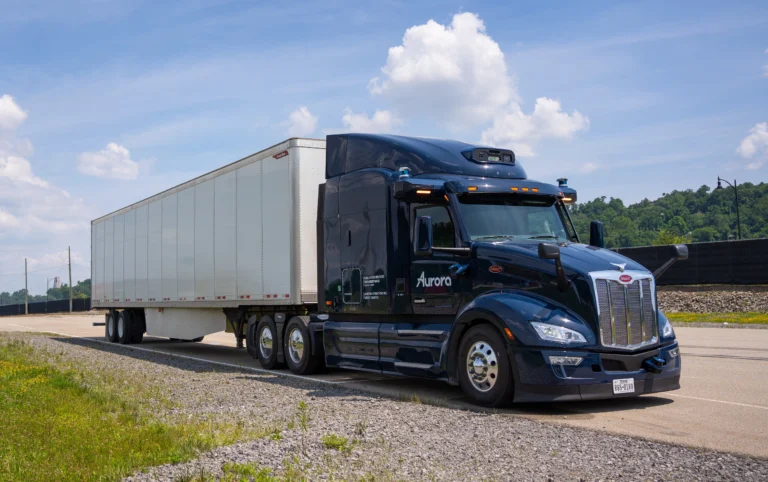WASHINGTON — Aurora Innovation has filed suit against the U.S. Department of Transportation (USDOT) and the Federal Motor Carrier Safety Administration (FMCSA) claiming the agency “arbitrarily” rejected the industry’s idea for an alternative solution for modern roadside warning devices.
“On Dec. 26, 2024, after two years of silent review, the Federal Motor Carrier Safety Administration (FMCSA) denied Aurora’s application to pilot modernized roadside warning systems in autonomous trucking,” said Ossa Fisher, president of Aurora, in a company media release. “While this does not prevent us from complying with existing regulations when we launch our driverless trucks in April, this decision raises a more important question: as Americans, how do we think about safety and innovation on our roads?
According to Fisher, Aurora, is driven by a “safety-always” culture. Its autonomous trucking fleet drives thousands of miles per week, and its work hauling freight for customers “deeply informs how we think about improving safety on the roadside.”
Fisher also noted that from the company’s experience:
- Safe, accessible roadside warning systems have already been implemented outside of trucking. Emergency and construction vehicles use high-visibility flashing lights to alert other drivers when stopped on the roadside. After prototypes, data-backed research, and engagement with safety experts, Aurora proposed a similar solution for trucking. Why are we denying this safety tool for America’s truckers?
- Today’s roadside warning system is outdated. The current warning system to indicate when a truck is stopped on the side of the road – hand placement of warning triangles – is not only over half a century old, it has never been updated and is not backed by any data or research showing that it improves safety.
- Urgent action is needed to reduce roadside fatalities. In the decades since this system was put in place, countless truck drivers have been killed by oncoming vehicles while placing these warning triangles. Yet, more than fifty years after warning triangles were mandated, FMCSA just this week announced that they are going to look into the crash prevention benefits of those devices for the first time.
“We have deep and enduring respect for our partners in government and we recognize the difficulty in modernizing a long-established system – regardless of its current ineffectiveness,” Fisher said.
Aurora is petitioning a court to revisit the FMCSA’s “unreasonable denial to use this innovative flashing light warning system.”
“We’re hopeful that this action can open a pathway to a fair evaluation of an innovative, and safer, solution,” Fisher said. “We live in the greatest country in the world, and it is my firm belief that the revolution in automotive safety technology that has taken place since the current roadside warning system was put in place in 1972 should be reflected in today’s trucking regulations.”
According to the release, as the U.S. government transitions with the incoming Trump administration, Aurora and the safety advocates supporting this solution know that there are hardworking, passionate transportation leaders ready to support innovation and save lives.
“We look forward to working with these leaders to update the archaic system used today and support a safer, more innovative future for trucking,” Fisher said.
According to the Federal Register, on Dec. 27, 2024, FMCSA denied an application from Waymo and Aurora Operations Inc. requesting an exemption from certain FMCSA’s related to requirements to place specific types of warning devices at prescribed locations around commercial motor vehicles (CMVs) stopped on the traveled portion or shoulder of a highway for any cause other than necessary traffic stops and requirements that lamps on CMVs be steady burning.
The companies requested that they and ‘‘other similarly situated companies’’ be permitted to instead use ‘‘Cab-Mounted Warning Beacons’’ (CMWBs), including “variants” and “any configuration of similar effectiveness,” when the CMV is operated by a Level 4 Automated Driving System (ADS) either without a human on board or with a human on board when testing the warning beacons.
“Safety is FMCSA’s highest priority,” the department said in a post on the Federal Register. “The agency embraces USDOT’s Innovation Principles, including adapting as technology changes and supporting technologies that further our policy goals. While the application and the public comments show promise for alternative warning devices to provide safety benefits for warning motorists of a stopped CMV under certain conditions, the present application does not demonstrate how Applicants or other proposed exempted parties would ensure an equivalent or greater level of safety than would be achieved absent the exemption. The application does not provide sufficient details about proposed alternative devices, and the limited data presented does not support a likely equivalent level of safety for a national, industrywide exemption for all companies operating autonomous CMVs. If applicants can reasonably address the reasons for the denial, applicants may resubmit an exemption application.”
Aurora responded to the denial by filing a petition on Jan. 10, 2025.
“Aurora and another entity (the “Applicants”) applied for an exemption (the “Application”) from certain Federal Motor Carrier Safety Regulations (“FMCSRs”) requiring human drivers of commercial motor vehicles (“CMVs”) to exit the vehicle (regardless of roadway and traffic conditions) and place reflective triangles, fusees or liquid-burning flares on the roadway when stopped on the road or shoulder of a highway,” Aurora said in its petition to review the denial.
The requested exemption would allow driverless, autonomous CMVs to utilize cab-mounted warning beacons instead of human-placed warning devices to alert road users when autonomous CMVs are stopped.
“Nearly two years after receiving the application, without asking any additional clarifying questions as allowed under the law, and despite the applicants’ submission of extensive research confirming the safety benefits and efficacy of CMWBs as compared to the otherwise-specified human-placed warning devices, FMCSA arbitrarily and capriciously denied the application contrary to record evidence and without adequate, reasoned explanation,” the petition said. “FMCSA’s decision stifles safety innovation and would impede the development of the autonomous trucking industry for no valid or lawful reason.”
Aurora also claimed in the suit, filed in the D.C. Circuit Court of Appeals, that the record before FMCSA demonstrates that CMWBs would achieve a level of safety at least equivalent to the level of safety absent the exemption. The application was supported by two separate studies, conducted by the Virginia Tech Transportation Institute and Aurora, reflecting the responses of several thousand road users across a variety of lighting conditions and interstate roadway geometries. Both studies demonstrated that CMWBs are equally or more effective in enabling road users to detect, recognize and react to the hazard presented by a CMV parked on a roadway as compared to human-placed warning devices, causing such road users to slow down and/or change lanes in response.
“FMCSA’s decision does not adequately explain, with non-arbitrary reasons, why the exemption request was denied given this robust record evidence,” the suit said.








You should have included a video example of the warning beacons. As a retired trucker, I think our voices on the subject would make a better jury than a bunch of black robed non-truck drivers or worse yet, cubicle chair sitters.